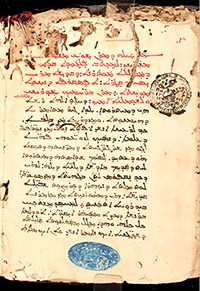 Each month, we ask a member of the Vanderbilt Divinity School faculty to recommend a book they are currently reading. Our October recommendation is offered by David A. Michelson, Assistant Professor of the History of Christianity, Affiliate Faculty Member in Classics and Islamic Studies.
Each month, we ask a member of the Vanderbilt Divinity School faculty to recommend a book they are currently reading. Our October recommendation is offered by David A. Michelson, Assistant Professor of the History of Christianity, Affiliate Faculty Member in Classics and Islamic Studies.
My recommendation for this month is Saint Isaac of Nineveh, On Asetical Life, translated by Mary Hansbury (Crestwood, N.Y.: St. Vladimir’s Seminary Press, 1989), https://www.svspress.com/on-ascetical-life/
Readers will find this short but deep book rewarding not only because it is a hidden pearl of the Christian mystical tradition but also because it offers a timely opportunity to encounter the diverse heritage of the religious and ethnic communities of Northern Iraq and Syria. There is no one in Syria or Iraq who has not suffered due to the ongoing violence, but for minority communities in the region the crisis is particularly acute. Some communities have been so shattered in the conquest by the self-proclaimed “Islamic State” that they may never return to the towns and villages that they have inhabited for more than a millenium.
The dire situation of how these communities are facing annihilation has finally caught the world’s attention. For example, recent press coverage has in particular highlighted the plight of the Yazidi minority.1 In spite of this recent media attention, it is still that case that the general public has little knowledge of the long and rich religious history of this region.
This ignorance is a real loss for several reasons. First, the centuries long presence of these minority communities offers us a different picture of the Middle East than the common misperception that the cultures of Iraq and Syria are monolithically Arab and Islamic. The historical facts on the ground are much more complex (a reality that the so-called Islamic State and others would like to eradicate). The disappearance of these diverse communities is a loss not only for the Middle East but for the world’s cultural heritage as a whole.
Secondly, some of these minority groups, particularly the Syriac Christian communities, have traditionally served as cultural bridges bearing witness to the long standing links (rather than “clashes”) between Middle Eastern and Western cultures. For Western Christians in particular these communities represent a vast, but little-known, part of their own religious heritage. Accordingly, the eclipse of Middle Eastern Christianity is a loss for Christians everywhere.

It is with these current events in mind, that we approach the writings of Saint Isaac of Nineveh. While reading a book will not directly address the pressing humanitarian concerns, preserving and spreading the memory of Isaac is nonetheless a small action against the forces which threaten to efface Isaac’s culture and community in the contemporary Middle East. For that reason, I chose this year to add Isaac to the syllabus for our first-year students at VDS.
Isaac of Nineveh was a Christian mystic, monk, author, and bishop who lived in the late 600s A.D. He was born near Qatar [https://syriaca.org/place/37.html] in the Persian Gulf sometime just after the rise of Islam. Isaac was a part of the “Church of the East” which was a flourishing branch of the Syriac-speaking Christian tradition. Syriac is a dialect of Aramiac which was once the common language of Mesopotamia. By the time of Isaac, Syriac-speaking churches could be found in an area stretching from Lebanon to Iran, India, and China. In short, Isaac lived at one of the high points for the flourishing of Christianity in the Middle East and Asia.2
At some point in the late 600s, Isaac was named bishop for the ancient biblical city of Nineveh [https://syriaca.org/place/144.html], a city in northern Iraq now known as Mosul [https://syriaca.org/place/139.html] (and unfortunately the center of much violence in 2014). Isaac did not last long as a bishop, however. It may be that his temperament was not suited to the administrative duties of a bishop. Isaac was a contemplative and mystic not interested in worldly advancement. It may also be that some of Isaac’s teachings on mercy and forgiveness were too radical for his contemporaries. In any case, he resigned his position after five months and retired to a monastery in Iran [https://syriaca.org/place/619.html] to continue his mystical practice and writings.
Among the writings he left are instructions on how to live a contemplative or ascetical life. The first set of these discourses have been beautifully translated from Syriac into English by Mary Hansbury. In On Ascetical Life we have Isaac’s advice to the beginner on what he calls “the way of life”.
For Isaac, the first step is to abandon “the fear of death” in favor of “the fear of God” which is, in the language of the Psalms, the beginning of wisdom. Isaac’s central concern is to help his readers to find freedom from the worldly concerns and attachments that keep their minds from true knowledge of God. The path toward divine knowledge proceeds inward in contemplation: “Be at peace with your soul and heaven and earth will be at peace with you. Endeavor to enter the treasury within you and you will see that treasury which is in heaven.”3 For Isaac, the key to this treasury is the contemplation of scriptures in one’s heart which leads to a knowledge of God which surpasses words.
Such mystical knowledge cannot, however, be reached without humility. One cannot know God without first acknowledging one’s own weakness. In fact, Isaac notes that real prayer is only possible in times of trial and tribulation because it is then when one approaches God as a friend rather than as a stranger.4. Moreover, admission of one’s own weakness also leads to a recognition of the interdependence of all creation: “Support the weak and distressed with a word [of scripture] as far as you are able, that the right hand upholding the universe may sustain you.”5 In a way that was radical, Isaac emphasized that divine mercy is extended to all creation, even trumping human misperceptions of justice. He explained:
“There is nothing which brings the heart as near to God as mercy…. Many will reprove you as ignorant because of your openhandedness [refusing to judge others]…they will say you are not wise or mentally unstable…. And when you give, give with a generous eye.… Do not distinguish between rich and poor, and do not determine who is worthy and who is not worthy. For your part treat all people as worthy of goodness, especially since thereby you will stimulate them to truth.” 6.
In short, the wisdom of Isaac of Nineveh has many ways that it can challenge us today. Not only can it connect its readers in solidarity with Syriac Christian communities currently facing extinction in the Nineveh plain, but through the cultural heritage of those communities it can expand our horizons of knowledge of both our fellow humanity and the divine.
About the translator: Dr. Mary Hansbury earned her Ph.D from Temple University with a dissertation on St. Isaac of Nineveh. Since that time she has rightly earned a reputation as skilled translator of Syriac texts. An associate of a monastic community herself, Dr. Hansbury’s translations show a sensitivity to how these Syriac texts can continue to foster contemplative practice.
About Syriac: Vanderbilt University is pleased to offer a number of ways to learn about the heritage of Syriac communities. This fall Vanderbilt Divinity School is offering beginning Syriac language and in the spring will offer for the first time an introductory course on Syriac Christianity. Moreover, several Vanderbilt students are also working with Dr. Michelson on an online resource www.syriaca.org designed to preserve these endangered cultures.
Footnotes
1. The BBC has a useful news report introducing some of the minorities of Iraq: Mina al-Lami, “Iraq: The Minorities of Nineveh Plain,” BBC News, https://www.bbc.com/news/world-middle-east-28351073.
2. Today the heirs of these communities preserve their Syriac heritage and identity under a variety of names such as Syriac, Assyrian, Aramean, Church of the East, Chaldean Catholic Church, Ancient Church of the East, Assyrian Evangelical Church, Syriac Orthodox, Syriac Catholic Church, Maronite, Syro-Malabar Catholic Church, Mar Thoma Church and others.
3. On Asetical Life, 34.
4. On Asetical Life, 58.
5. On Asetical Life, 36.
6. Adapted from On Asetical Life, 76.

This blog post is © David A. Michelson, 2014, and licensed under a Creative Commons Attribution 4.0 International License. Reuse is encouraged.